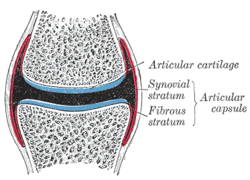| Capsulitis | |
|---|---|
 | |
| Joint capsule(articular capsule) | |
| Specialty | Orthopedic |
In anatomy, capsulitis is inflammation of a capsule. [1]
Contents
Types include:
- Adhesive capsulitis of shoulder
- Plica syndrome, which is an inflammation of the articular capsule of the knee joint